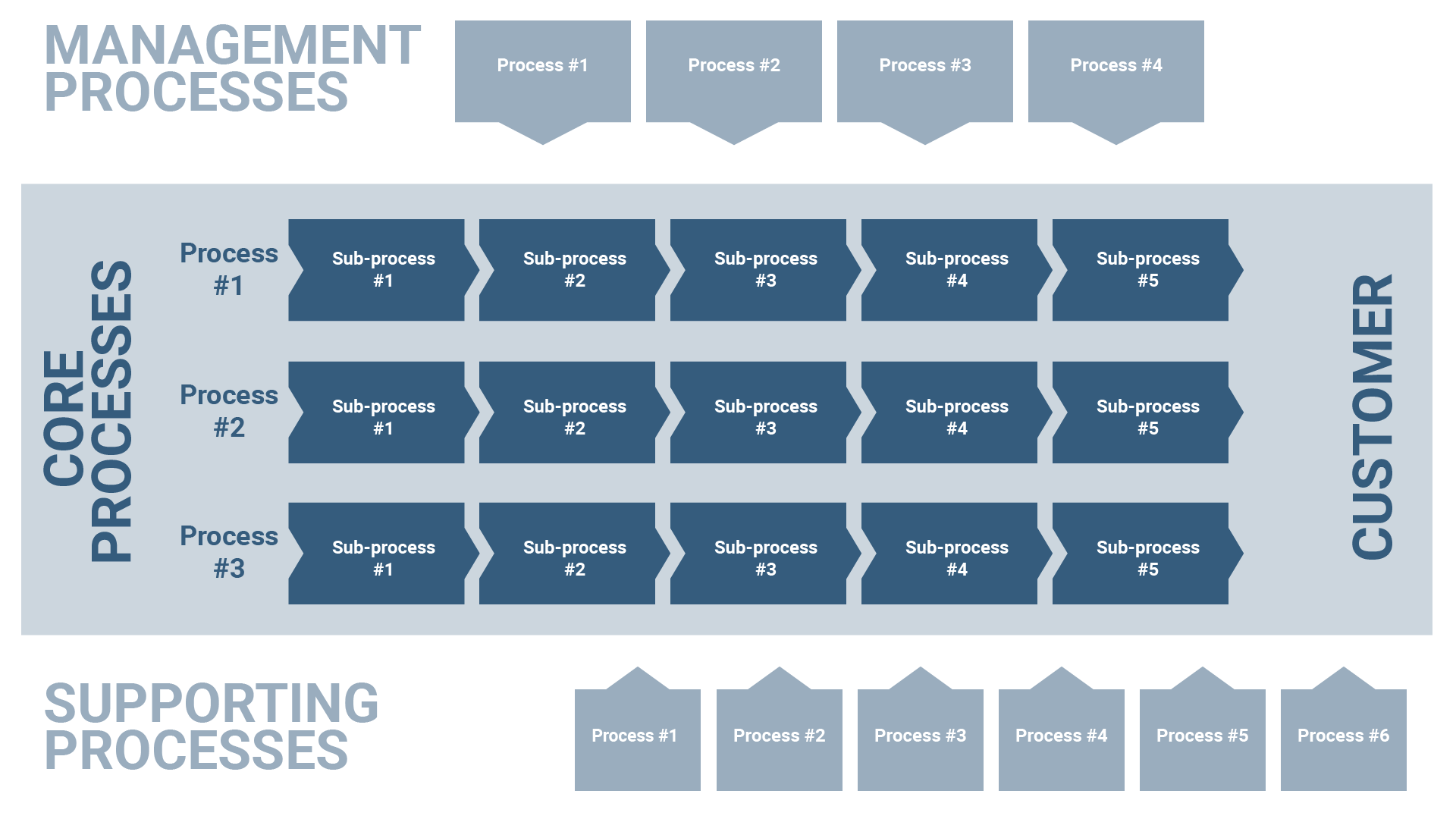Process digitalization: definition and goal
At the end of 2023, Staufen AG and Applied IT conducted a survey on digitalization*. Half of the companies surveyed stated that they were intensifying their digitalization efforts despite - or precisely because of - the current crises. And for 82 percent of these companies, the “process digitalization” was the top priority.
The only question is: what exactly does this process digitalization mean and which processes are actually meant? Generally speaking, the process digitalization goes beyond production and the manufactured product and deals with all processes in the company - i.e. business processes. In principle, you could say that all processes that are analogue, paper-based or otherwise non-digital are digitalized or even automated.
Process digitalization option 1: Digitalization as a goal in itself
This is what we call Business Process Digitization (BPD) and it means nothing other than that analogue formats are now made available in digital format. This means that data and information are available anytime and anywhere. Examples of process digitalization could be
- digital work instructions in production
- digital accounting in the bookkeeping department
Process digitalization option 2: Automation as a goal
Automation - or business process automation (BPA) - goes one step further. Here, recurring, rule-based tasks are carried out automatically without human intervention. The technology controls the processes and predefined rules enable automated decision-making. Examples of this could be
- Robotic Process Automation (RPA): software robots create user accounts for new employees
- Machine Learning: machines make decisions independently based on historical data
- AI: chatbots respond to customer inquiries based on knowledge databases
* Source: Staufen AG
Now that we have asked this question, we need to put it into perspective: There are a whole range of reasons that can depend on the company. But in general, you could say that analog processes cost unnecessary time and nerves. Why is that? A few examples:
- Documentation processes with pen and paper are time-consuming. Not only does the documentation itself cost nerves, you also always need to know what needs to be documented when and where in order to comply with compliance or the GDPR, for example.
- At best, everything noted is filed away. But even then, and even more so if this has not been done, searching for information in folders and in your collection of notes is time-consuming and slows down decision-making.
- You know when something is shouted at you between doors? The information is now literally in the room and will fizzle out if you don't write it down.
- Digital means available everywhere. Analog, on the other hand, means long travel times to obtain and distribute information.
- Analog knowledge is isolated knowledge - local or temporary.
- Everything that is written down by hand can be lost or damaged. The note often exists only once, and once it is gone, information is lost.
- The analog transfer of information is far more prone to error than digital information. It is not even always clear where and when the error occurred.
- The time required for analog processes is significantly higher. How much time could you save if you could provide services digitally instead of on site? How much travel time would digital appointments save you?
We have just looked at the reasons for processes digitalization and the greatest benefits of the transition from analogue to digital are already becoming apparent. But let's put it into words. Through processes digitalization you:
![]()
improve the flow of information and optimize data availability
![]()
optimize workflows and increase effectiveness and productivity
![]()
reduce sources of error and increase process reliability
![]()
eliminate process gaps and establish seamless traceability
![]()
present yourself as an attractive, digital company and counter the shortage of skilled workers
![]()
save time and costs and take the pressure off your employees
![]()
bring more flexibility to your processes and establish standards at the same time
![]()
increase your customer focus and competitiveness
![]()
arm yourself against crises
As with so many topics, process digitalization also brings challenges. Join us in looking at possible objections:
The skeptic:
„I lack employee acceptance for process digitalization.“
![]()
iSAX:
“You can prevent this by involving your employees in the process right from the start. Point out the problems to them, explain the benefits and train your employees regularly as soon as the solution is used.”
![]()
The skeptic:
„Digital is all well and good, but we'll never be able to reconcile that with our security requirements.“
![]()
iSAX:
„This can usually be researched very well or discussed with the providers. Many current solutions MUST guarantee certain security standards. And these are often probably not that far removed from the company's requirements.“
![]()
The skeptic:
„You can't digitize everything. There's now way working without my employees.“
![]()
iSAX:
„It doesn't have to and it shouldn't. People will always remain the focus of the company. That is why digitalization should not be an end in itself. Talk to the departments and find processes that will bring your employees tangible added value through digitalization or automation.“
![]()
The skeptic:
„If I introduce a digital solution now, won't I be building isolated solutions again and causing media disruptions?“
![]()
iSAX:
„There is a risk if you do not pay attention to integrability when selecting a solution. Make sure that new solutions have open interfaces. Then integrated and holistic software landscapes are no problem.“
![]()
The skeptic:
„Our processes are way too complex.“
![]()
iSAX:
„This may well be the case, but that doesn't mean you can't tackle process digitalization. Graphically depict the desired processes and break down what currently takes place and how. Then you can easily find starting points for digitalization. And if in doubt, an experienced digitalization partner will certainly be happy to support you with the implementation.“
![]()
That all sounds great, doesn't it? Then you'd better start optimizing your processes right away. But wait a minute. Perhaps it makes sense to take another look at which processes exist and how much impact they have on your company. Don't worry, this won't be an endlessly long list. We “only” distinguish between two types here.
1. Core processes
Roughly speaking, these are all processes that are in some way connected to the customer - i.e. customer service, sales, contract management and production. Consequently, process digitalization in these areas also has a direct impact on the customer relationship and your business success.
And these can be very simple things, such as the digital preparation of quotations or the provision of order-related data. Provide your customers with digital support portals and make important information available across the board. Offer digital services such as remote maintenance and save yourself and the customer time and money.
2. Supporting processes
Supporting processes are administrative processes that are not directly related to your customers. These include, for example, accounting and finance, purchasing, logistics and warehouse management, HR or facility management.
Process digitalization in this area will have an impact on the corporate culture and your resource planning. This includes topics such as processing incoming invoices, time recording, business trip management, processing and triggering orders, personnel files and performance records as well as online meetings.
Strictly speaking, there is a third category, the management processes. This is primarily concerned with strategy, controlling, audits and legal and social issues.
Of course, there is also potential for digitalization here, but basically all these processes are the superstructure that secures and frames the actual customer-centric processes. Here and in the following text, we will focus primarily on value-adding processes.
At iSAX, we make sure that your (manual) production runs optimally. That's why we want to take a closer look at the background to the production process at this point.
As we have just established, production processes are core processes. Their digitalization therefore benefits the customer to a large extent. And if we look at the four phases of the production process, it becomes clear how many manual and recurring processes are involved - processes that can be digitalized.
1. Work scheduling
It defines what is to be produced, how much raw material is required, how much it costs to produce and how much effort is involved. This requires a lot of “brain power” and “number crunching”. Of course, this can also be done on paper, but digital systems can significantly reduce the workload and create and use important data bases.
2. Work process
At this point, the exact workflow is defined. What subtasks are there? In what order must they be completed? Who can carry out these tasks? When are quality checks carried out? The answers to these questions are best found in the digital work instructions of a worker guidance system.
3. Scheduling
How much time is needed for each task? How are resources scheduled? Time management is essential for successful production and without a digital tool, you are making your life unnecessarily difficult.
4. Start of production
Now give the start command for the actual production based on the previously defined planning. If you have overlooked something somewhere, this will become clear here at the latest. The more digital you were in steps 1 to 3, the lower the probability of errors here. And phase 4 itself can also be ideally supported by digital solutions - keyword worker guidance system.
![]()
1. Define the processes
The first step is to find out what a process actually is in your company and which processes exist as a result. Process maps, process descriptions, organizational charts, etc. can help you do this.
![]()
2. Check the processes for up-to-dateness and optimization potential
Do you already know our motto on the subject of process digitalization? “A bad process is still a bad process when digitized.” In concrete terms, this means: don't replace the analog process one-to-one with a digital version, but make it better. Optimize inefficient processes in the course of process digitalization and coordinate with the specialist departments on current workflows and challenges.
![]()
3.Determine the current level of digitization
This can apply to individual processes, but also globally. How digitized is your company already?
- Level 1: Your processes are still paper-based.
- Level 2: Few processes are digitalized.
- Level 3: There are still intermediate steps between the digital solutions, which are carried out in analog form.
- Level 4: Your processes are fully digitized.
Level 4 will probably not apply to you, otherwise you would not be reading this text. But whether you are in stage 1, 2 or 3 makes a fundamental difference to how you approach process digitalization.
![]()
4. Prioritize processes according to economic benefits and costs
Don't put your energy into digitizing small peripheral processes, but instead focus on where it really hurts. Or rather, where it will help you the most. To do this, evaluate
- the frequency of the process (repetitive / routine work)
- the current effort required to carry out the process
- possible potential for improving the process (quality, time, costs)
- costs and possible additional expenses due to digital solutions
![]()
5. Search for solutions and partners
You should now have an overview of which processes can be digitized in a meaningful and beneficial way. Next, analyze and compare possible standard solutions depending on your chosen area of application. These could be
- an ERP for the digitalization of commercial processes
- a CRM for digitizing all customer-related information
- a DMS for digitizing documents
- a worker guidance system for digitizing manual processes in production
Sometimes standard solutions also include functionalities for other scenarios. A good worker assistance system, for example, can also map simple shop floor data collection scenarios, as it records and documents all relevant data in the process anyway.
In other cases and if you have already achieved a certain level of digitalization, for example, you should also consider custom software as an extension of standard solutions. Whatever area you are researching, remember to appoint a project manager who will take care of the technical implementation.
If you find that you need support, look for experienced digitalization partners who are familiar with the digitalization of production and have the relevant expertise.
![]()
6. Introduction of the new solution
At the end of step 5, you should have found or developed a suitable solution. Now you can introduce the solution in your company. In addition to the purely technical introduction and the migration or import of data, it is now essential to define and document the new processes. You should also train your employees so that they can work optimally with the new processes.
![]()
7. Process monitoring
Now that you can monitor the processes digitally, you should also do this continuously. Make sure that all data is available in such a way that you or your employees can work with it without errors. Carry out target/actual analyses and uncover potential for optimization. A digital process is also open to improvement.

Example #1
What?
Digitization of manual work steps in production
How?
Digital step-by-step instructions are made available to the worker directly at the workplace. These are enriched by various media, such as text, images, 3D drawings and videos.
Technology?
Worker guidance system weasl
The result?
Paper-based work instructions and routing slips disappear from production. Conventional digital work instructions in Excel and PDF can also be replaced.
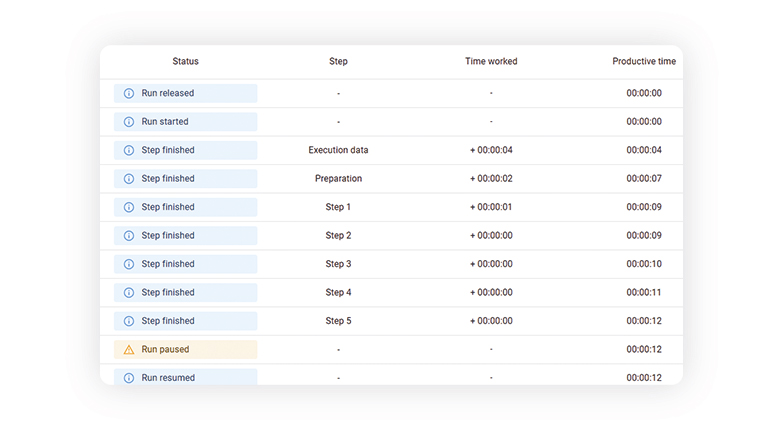
Example #2
What?
Transparency of production orders in production
How?
The work steps carried out and data entered are automatically documented by a digital system during processing and made available for review.
Technology?
Worker guidance system weasl
The result?
You receive an overview of the current processing status of orders and gain transparency for later traceability, e.g. in the event of a complaint.
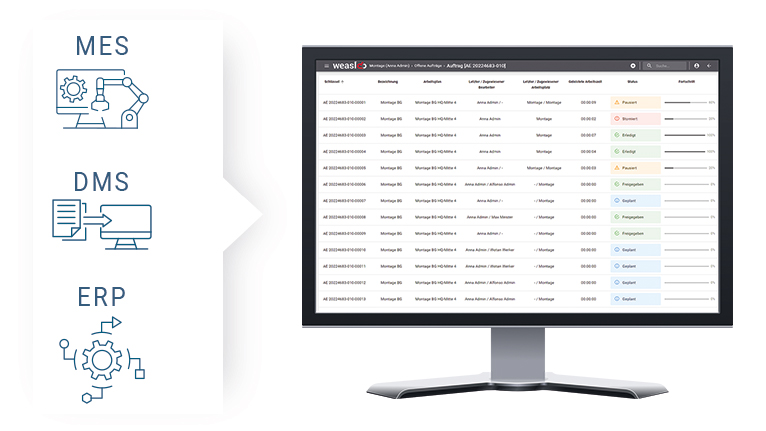
Example #3
What?
Avoidance of media discontinuities in production
How?
The data generated by the system or entered into the system is automatically recorded and transferred to third-party systems via open interfaces. This creates digital consistency and eliminates the need to change media.
Technology?
Worker guidance system weasl
The result?
They close the gaps between digital systems and avoid the error-prone transfer from analog to digital media.
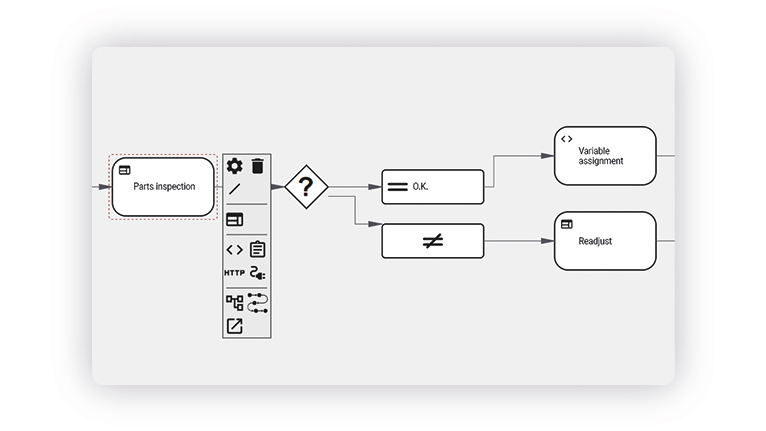
Example #4
What?
Process modeling in production
How?
With the help of a graphical process editor, you can digitally map assembly and production processes 1 to 1. To do this, you first model the target process, for example, and then see what deviations there might be. You adjust the modeling accordingly until the process fits.
Technology?
Worker guidance system weasl
The result?
You get an overview and transparency of the processes in production.
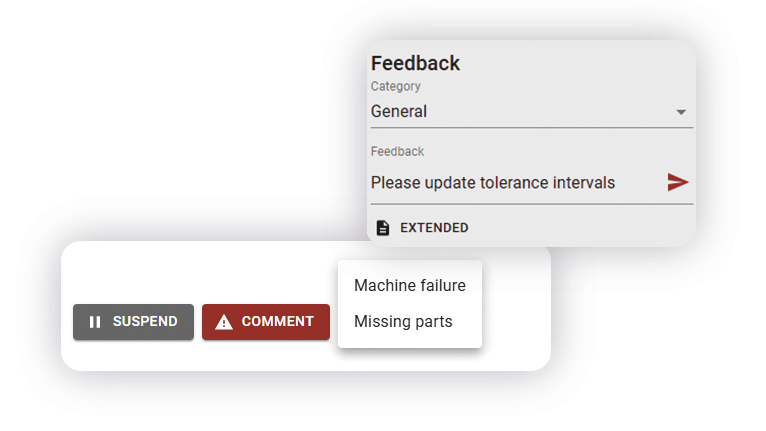
Example #5
What?
Continuous improvement processes (CIP) in production
How?
For example, record employee feedback or reasons for faults and error classes while your employees are working on their orders. Evaluate the collected information to identify optimization potential.
Technology?
Worker guidance system weasl
The result?
You have the opportunity to monitor processes end-to-end and make flexible adjustments where optimization is required.
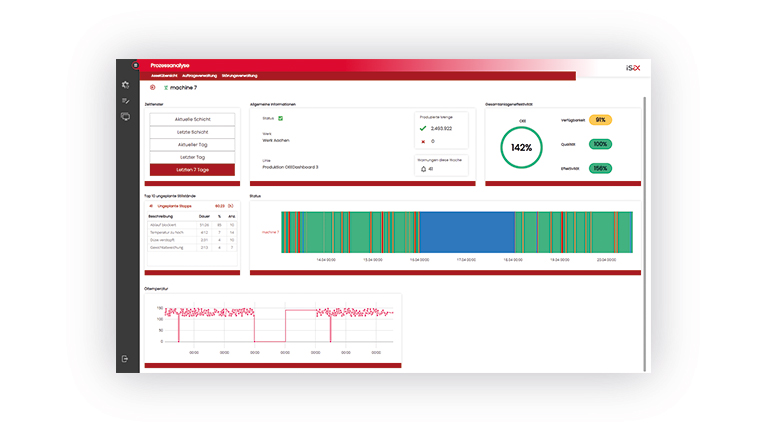
Example #6
What?
Individually modeled process digitization
How?
On the basis of digitization platforms, you can develop individual solutions that are effective wherever standard solutions do not work. One example: If you want to visualize key figures in a meaningful way and use them for forecasts, an individual dashboard tailored to your company makes sense.
Technology?
IoT platforms such as ThingWorx, Cumulocity or AWS IoT
The result?
You receive a solution that integrates into your company, fits your requirements and provides data in such a way that it is of maximum benefit to you.
Conclusion
Process digitalization is at the top of the list for many companies. However, due to the large number of processes, it is important to research which process digitalization will bring the greatest benefits for the company and your customers.
Focus on core processes, for example in production, and make sure that you opt for user-friendly and end-to-end solutions. After all, process digitalization should not be an end in itself, but should provide your employees with optimal support and enable you to derive the next optimization steps on the basis of data.

